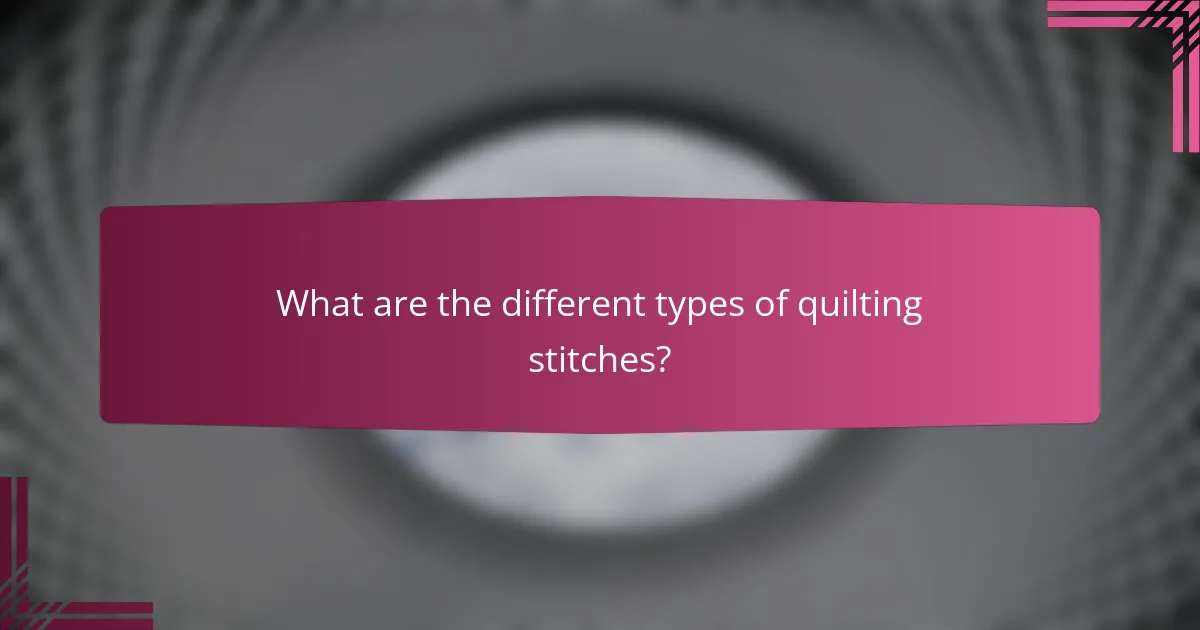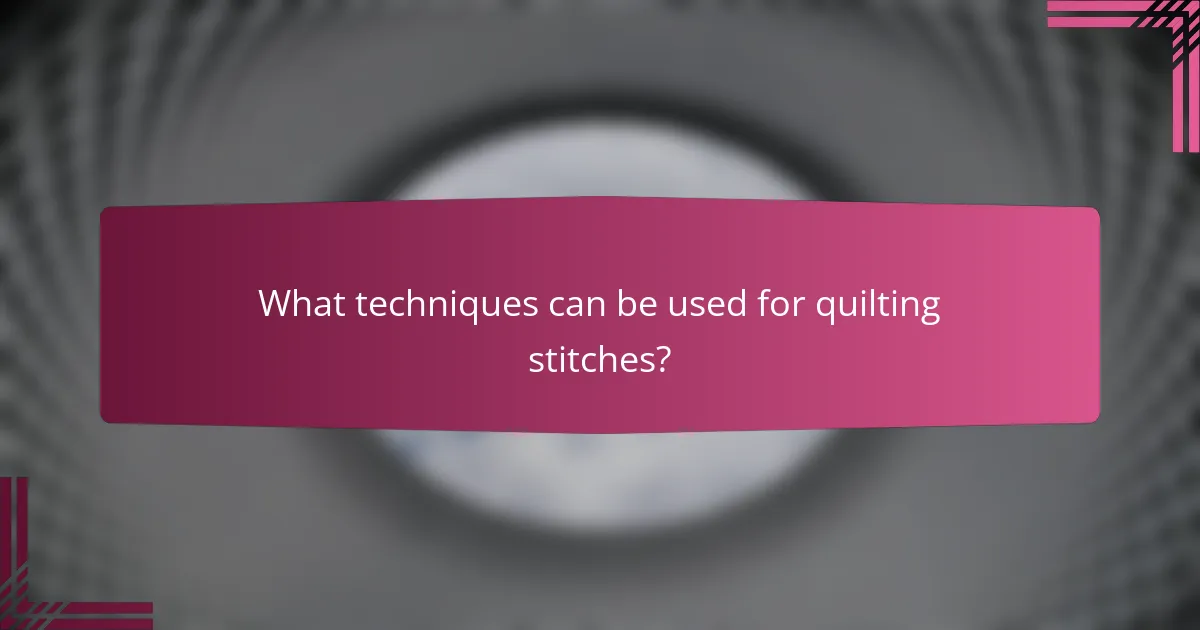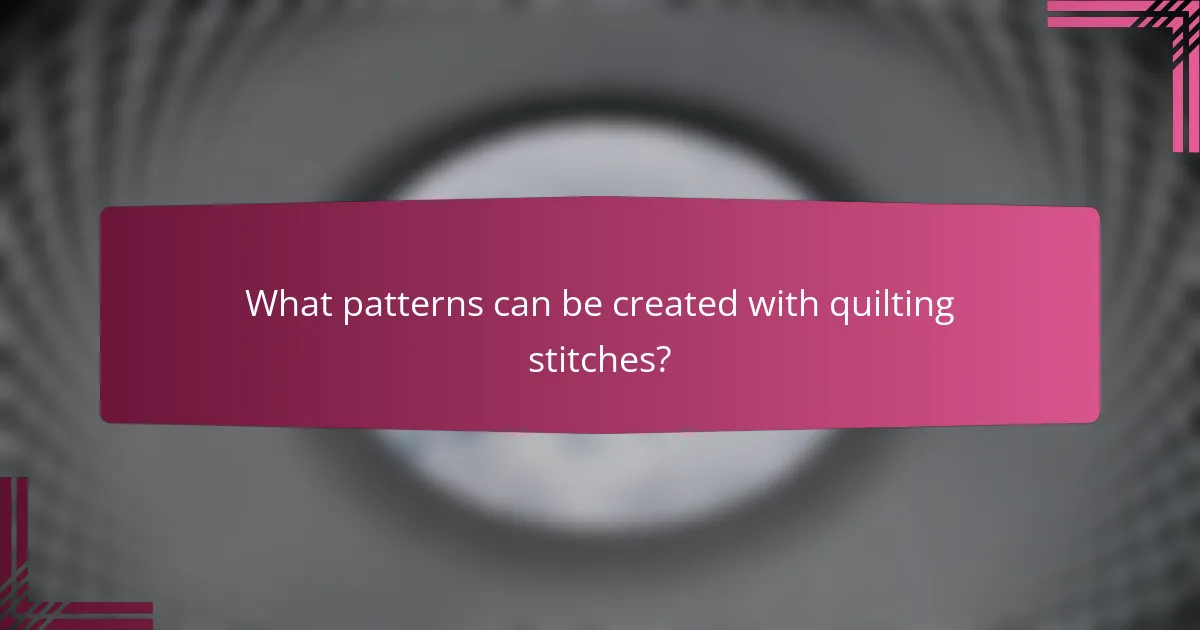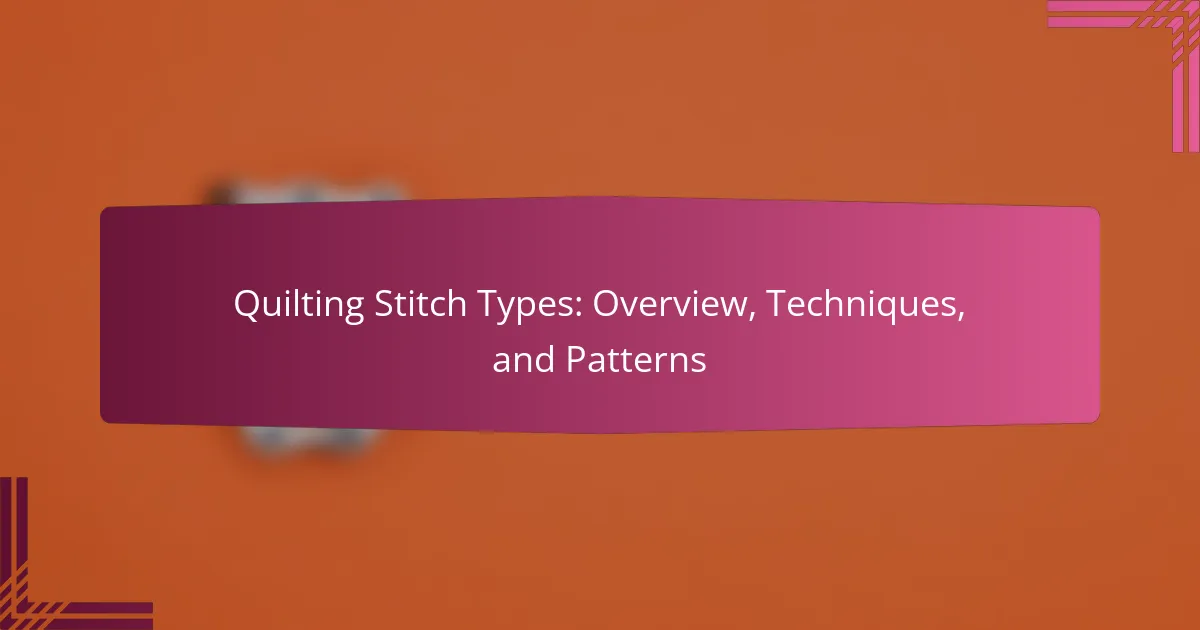
What are the different types of quilting stitches?
The different types of quilting stitches include straight stitches, zigzag stitches, and decorative stitches. Straight stitches are the most common and provide a clean, simple line. Zigzag stitches allow for more flexibility and can be used for appliqué and reinforcing seams. Decorative stitches add intricate designs to quilts and can enhance their visual appeal. Other types include hand quilting stitches, machine quilting stitches, and free-motion quilting stitches. Hand quilting stitches are often smaller and can create a more traditional look. Machine quilting stitches are faster and can cover larger areas quickly. Free-motion quilting allows for creative patterns and designs. Each type of stitch serves different purposes in quilting, contributing to both functionality and aesthetics.
How do quilting stitch types vary in technique?
Quilting stitch types vary in technique based on their application and execution methods. Hand quilting utilizes a needle and thread to create stitches manually. This method allows for intricate designs and personalized touches. Machine quilting employs a sewing machine, which can produce uniform stitches quickly. This technique is efficient for larger projects.
There are different styles within these categories. For example, straight stitching is common in both hand and machine quilting. It provides a clean, simple look. Free-motion quilting allows for creative, flowing patterns. This technique can be more challenging but offers artistic freedom.
Each quilting stitch type serves different purposes. Decorative stitches enhance visual appeal. Functional stitches secure layers of fabric together. The choice of technique influences the overall look and durability of the quilt.
What are the most common hand quilting stitches?
The most common hand quilting stitches include the running stitch, backstitch, and whip stitch. The running stitch is a simple stitch that creates a straight line of evenly spaced stitches. It is often used for both quilting and basting layers together. The backstitch provides a strong seam by overlapping stitches, making it ideal for securing edges. The whip stitch is used to join two pieces of fabric, often seen in finishing edges. These stitches are foundational in hand quilting and widely taught in quilting classes. Their versatility allows quilters to create intricate designs and secure layers effectively.
What are the popular machine quilting stitches?
The popular machine quilting stitches include straight stitch, zigzag stitch, and free-motion quilting. Straight stitch is commonly used for basic quilting and piecing. Zigzag stitch adds decorative flair and can help prevent fraying. Free-motion quilting allows for creative designs and patterns. Other popular stitches are decorative stitches like serpentine and stippling. Each stitch serves different purposes in quilting. They enhance both the functionality and aesthetics of quilted projects.
Why is it important to choose the right quilting stitch type?
Choosing the right quilting stitch type is essential for the durability and aesthetic of the quilt. Different stitch types provide varying levels of strength and flexibility. For instance, straight stitches are commonly used for piecing fabrics together. They offer a strong hold but may not provide the same decorative effect as other stitches. Decorative stitches can enhance the visual appeal but may not be as sturdy.
The choice of stitch also affects the quilt’s overall texture and drape. A tight stitch can make a quilt stiffer, while a looser stitch allows for more movement. Furthermore, selecting the appropriate stitch type can influence how well the quilt withstands washing and wear over time. Quilts with inappropriate stitch types may unravel or lose shape.
Ultimately, the right stitch type ensures that the quilt meets both functional and design expectations. This is crucial for the longevity and enjoyment of the finished product.
How does stitch type affect the overall quilt design?
Stitch type significantly influences the overall quilt design. Different stitch types create varying textures and visual effects. For example, straight stitches provide a clean and modern look. Meanwhile, decorative stitches add intricate details and enhance the quilt’s aesthetic appeal. The choice of stitch type also affects the quilt’s durability and how well it holds together. Certain stitches, like quilting stitches, are designed specifically to secure layers of fabric. Additionally, the stitch type can impact the quilt’s drape and flexibility. Overall, selecting the appropriate stitch type is crucial for achieving the desired design and functionality in quilt making.
What role does fabric type play in stitch selection?
Fabric type significantly influences stitch selection in quilting. Different fabrics have varying weights, textures, and stretch properties. For instance, lightweight fabrics require finer, more delicate stitches to prevent puckering. Heavier fabrics, like denim, need stronger stitches to withstand tension. Stretch fabrics, such as knits, benefit from zigzag or stretch stitches to accommodate movement. Additionally, the weave of the fabric affects how stitches appear on the surface. Looser weaves may show stitches more prominently, while tighter weaves can hide them. Choosing the appropriate stitch for each fabric ensures durability and enhances the overall aesthetic of the quilt.

What techniques can be used for quilting stitches?
Quilting stitches can be created using several techniques. Common techniques include straight stitching, zigzag stitching, and free-motion quilting. Straight stitching is often used for basic seams and outlines. Zigzag stitching adds flexibility and can prevent fraying. Free-motion quilting allows for creative designs and patterns. Hand quilting is another technique that involves stitching by hand for a personal touch. Each technique has its own unique style and application in quilting. Techniques can also vary based on the type of quilt being made.
How do you execute basic quilting stitch techniques?
To execute basic quilting stitch techniques, start by preparing your fabric layers. Lay out the backing, batting, and quilt top in order. Secure the layers with safety pins or basting stitches to prevent shifting. Choose a basic stitch type, such as straight, zigzag, or decorative. Use a sewing machine or hand needle for stitching. Guide the fabric steadily while sewing to maintain even stitches. Adjust stitch length according to fabric thickness; shorter stitches work well for quilting. Regularly check the tension settings on the sewing machine for consistent results. Proper execution of these techniques creates a durable quilt.
What are the steps for hand quilting stitches?
To hand quilt stitches, follow these steps. First, gather your materials: fabric, batting, needle, thread, and thimble. Next, prepare your quilt sandwich by layering the backing, batting, and top fabric. Secure the layers with safety pins or basting stitches. Then, thread your needle and knot the end of the thread. Start stitching from the top layer, pushing the needle through all layers and pulling it out. Make small, even stitches for consistency. Continue stitching in a pattern or design of your choice. Finally, when finished, tie off the thread securely and trim any excess.
How do you set up a sewing machine for quilting stitches?
To set up a sewing machine for quilting stitches, start by installing a quilting foot. This foot allows for better visibility and control while sewing. Next, select the appropriate needle, such as a quilting needle, which has a tapered point for penetrating multiple layers of fabric. Adjust the stitch length to a longer setting, typically between 2.5 to 3.0 mm, to accommodate the thickness of quilt layers. Set the machine to a straight stitch or a zigzag stitch, depending on the desired quilting pattern. Ensure the feed dogs are engaged for proper fabric movement. Finally, use a walking foot if available, as it helps to evenly feed multiple layers of fabric. These steps ensure optimal performance and quality in quilting stitches.
What advanced techniques exist for quilting stitches?
Advanced quilting stitch techniques include free-motion quilting, stitch-in-the-ditch, and echo quilting. Free-motion quilting allows for creative designs by moving the fabric freely under the needle. This technique requires a specialized foot and practice to master. Stitch-in-the-ditch involves sewing along the seams of the quilt top. It provides a clean finish while securing layers together. Echo quilting creates a series of lines around a design element. This technique enhances the visual appeal of the quilt. Other techniques include trapunto, which adds dimension, and appliqué stitching, which attaches fabric shapes to the quilt. Each technique offers unique aesthetics and enhances the overall design.
How can you incorporate decorative stitches into your quilting?
Incorporating decorative stitches into quilting enhances visual appeal and texture. Use a sewing machine with decorative stitch options. Select stitches that complement the quilt design. Experiment with thread colors for added contrast. Apply decorative stitches along seams or borders for emphasis. Utilize free-motion quilting techniques for unique patterns. Practice on scrap fabric to refine skills before applying to the quilt. Decorative stitches can also serve as quilting lines, adding dimension and interest.
What are the benefits of free-motion quilting techniques?
Free-motion quilting techniques offer several benefits. They allow for greater creativity and artistic expression in quilting. Quilters can create intricate designs that are not possible with standard sewing methods. This technique enables the quilter to move the fabric freely under the needle. It results in unique patterns tailored to individual preferences. Free-motion quilting also enhances the texture of the quilt. This technique can be used on various fabric types and thicknesses. Additionally, it can speed up the quilting process for larger projects. Overall, free-motion quilting techniques provide versatility and personalization in quilt-making.

What patterns can be created with quilting stitches?
Quilting stitches can create a variety of patterns, including straight lines, curves, and intricate designs. Common patterns include stippling, echo quilting, and free-motion quilting. Stippling creates a dense, meandering design that fills space. Echo quilting involves stitching parallel lines around a shape, creating a layered effect. Free-motion quilting allows for artistic freedom, enabling unique designs. Other patterns include crosshatching, which forms a grid-like appearance, and floral motifs that add decorative elements. Each pattern enhances the visual appeal of the quilt while showcasing the quilter’s skill.
How do different quilting stitches influence pattern design?
Different quilting stitches significantly influence pattern design by altering texture, depth, and visual appeal. Stitches like straight, zigzag, and decorative stitches each create distinct effects on fabric. For example, straight stitches provide a clean, flat finish that emphasizes the pattern’s geometry. Zigzag stitches add a sense of movement and can enhance the overall design’s dynamism. Decorative stitches introduce intricate details, making patterns more visually complex. The choice of stitch affects how light interacts with the fabric, influencing the perceived color and pattern clarity. Additionally, the density of stitches can change the fabric’s drape and structure, impacting the overall design outcome.
What are some popular quilting stitch patterns?
Some popular quilting stitch patterns include straight stitch, zigzag stitch, and free-motion quilting. Straight stitch is commonly used for piecing fabric together. Zigzag stitch adds flexibility and can be used for finishing edges. Free-motion quilting allows for creative designs and patterns. Other notable patterns are echo quilting, stippling, and crosshatching. Echo quilting creates a series of concentric lines. Stippling involves small, curvy shapes for texture. Crosshatching features a grid of diagonal lines. Each pattern serves to enhance the quilt’s design and functionality.
How can you create custom patterns using quilting stitches?
To create custom patterns using quilting stitches, start by selecting a variety of stitch types. Common stitch types include straight, zigzag, and decorative stitches. Next, plan your design on paper or digitally. This allows for visualization of the pattern before stitching. Use a fabric marking tool to outline your design on the fabric. Choose thread colors that complement your fabric. Experiment with stitch length and width settings on your sewing machine. Finally, practice on scrap fabric to ensure the stitch looks as intended. This method allows for unique, personalized quilting patterns.
What tips can improve your quilting stitch patterns?
To improve your quilting stitch patterns, focus on consistent tension and practice regularly. Consistent tension ensures even stitches, which enhances the overall appearance of the quilt. Regular practice allows you to develop muscle memory for smoother movements. Additionally, use high-quality thread suitable for your fabric type. This choice minimizes fraying and breakage, resulting in cleaner stitches. Experiment with different stitch types and patterns to find what works best for your style. Utilizing a walking foot can help maintain even spacing in straight lines. Lastly, take your time and be patient with the process to achieve the best results.
How do you troubleshoot common issues with quilting stitches?
To troubleshoot common issues with quilting stitches, first identify the specific problem. For skipped stitches, check the needle for damage or incorrect size. Ensure the thread is properly threaded through the machine. If stitches are uneven, adjust the tension settings on the sewing machine. For thread bunching, re-thread the machine and check for lint buildup in the bobbin area. If the fabric puckers, use a walking foot to maintain even feed. Additionally, ensure the needle is appropriate for the fabric type. These steps address the most frequent issues encountered in quilting.
What best practices should you follow for consistent quilting stitches?
To achieve consistent quilting stitches, maintain an even tension throughout the stitching process. Use a quilting foot designed for your machine to ensure proper fabric movement. Select the appropriate needle size and type based on the fabric being used. Regularly clean and oil your sewing machine to prevent mechanical issues. Practice on scrap fabric to establish a steady pace and rhythm. Adjust the stitch length according to the fabric thickness for uniformity. Finally, keep the fabric flat and aligned to avoid puckering. These practices help ensure that stitches are uniform and aesthetically pleasing.
Quilting Stitch Types encompass various techniques and patterns essential for creating quilts. This article provides an overview of different quilting stitches, including straight, zigzag, and decorative stitches, along with their applications in hand and machine quilting. It discusses the importance of selecting the right stitch type based on fabric and design, as well as advanced techniques like free-motion quilting. Additionally, the article covers troubleshooting common issues, best practices for consistent stitching, and tips for creating custom patterns, ensuring both functionality and aesthetic appeal in quilting projects.
